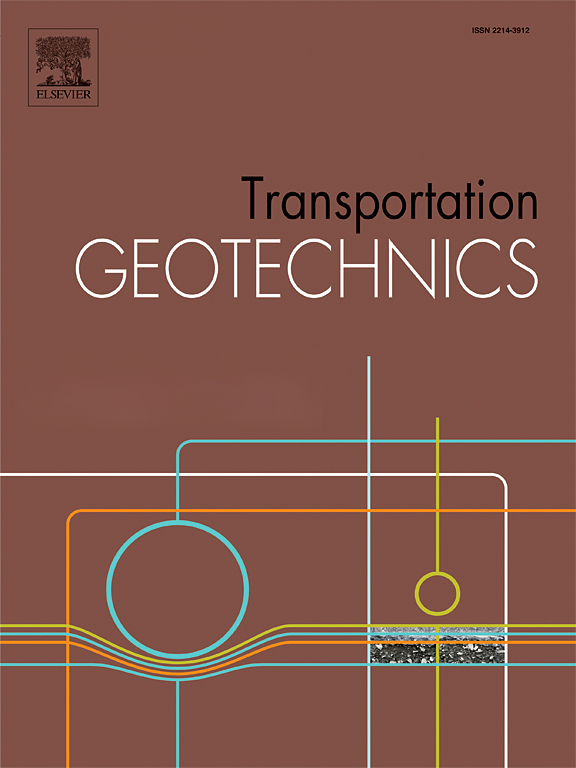A simple model incorporating foam rheology to quantify foam penetration behaviour in EPB shield tunnelling
IF 4.9
2区 工程技术
Q1 ENGINEERING, CIVIL
引用次数: 0
Abstract
Fulfilling the role of a soil conditioner, foam plays a pivotal role in Earth Pressure Balance (EPB) shield tunnelling by enhancing soil properties such as lowering permeability and increasing flowability. This study introduces a macro-model designed to quantify foam penetration behaviour in saturated sand, utilising rheological properties. To validate this model, experiments were conducted to replicate the foam penetration behaviour. Six sand beds characterised by varying particle sizes, along with foam having an expansion ratio of fifteen, were employed for penetration tests under different hydraulic conditions utilising a sand column device. The rheological profile of the foam is described by the power-law model, as also found by rheometer tests, although with different parameters. The flow behaviour of foam within the sand column conforms to the flow equation that governs power-law fluids in porous media. The developed model effectively predicts the foam penetration process under varying hydraulic conditions compared with the experimental results. Furthermore, the fitting results of the experimental data indicate that the flow behaviour index of the foam remains approximately 0.09 across all tests, regardless of the type of sand used. In contrast, the model-derived generalised permeability coefficient strongly correlates with the effective particle size (d10) of the sand bed. Overall, the model effectively quantifies the foam penetration behaviour, accounting for changes in infiltration velocity and pore water pressure, which is essential for understanding the transfer of support pressure in EPB shield tunnelling.
结合泡沫流变学的简单模型,量化 EPB 屏蔽隧道中的泡沫穿透行为
泡沫在土压平衡(EPB)盾构掘进中扮演着土壤改良剂的角色,通过增强土壤性质(如降低渗透性和增加流动性)发挥着举足轻重的作用。本研究介绍了一种宏观模型,旨在利用流变特性量化泡沫在饱和砂中的渗透行为。为验证该模型,进行了泡沫渗透行为的实验。在不同的水力条件下,利用砂柱装置对六个颗粒大小不同的砂床以及膨胀比为 15 的泡沫进行了渗透测试。泡沫的流变曲线由幂律模型描述,流变仪测试也发现了这一点,但参数不同。泡沫在砂柱中的流动行为符合多孔介质中幂律流体的流动方程。与实验结果相比,所建立的模型能有效预测不同水力条件下的泡沫渗透过程。此外,实验数据的拟合结果表明,无论使用哪种类型的砂,泡沫在所有试验中的流动特性指数都保持在 0.09 左右。相比之下,模型得出的广义渗透系数与砂床的有效粒径(d10)密切相关。总体而言,该模型有效地量化了泡沫的渗透行为,考虑了渗透速度和孔隙水压力的变化,这对于理解 EPB 护盾隧道中支撑压力的传递至关重要。
本文章由计算机程序翻译,如有差异,请以英文原文为准。
求助全文
约1分钟内获得全文
求助全文
来源期刊

Transportation Geotechnics
Social Sciences-Transportation
CiteScore
8.10
自引率
11.30%
发文量
194
审稿时长
51 days
期刊介绍:
Transportation Geotechnics is a journal dedicated to publishing high-quality, theoretical, and applied papers that cover all facets of geotechnics for transportation infrastructure such as roads, highways, railways, underground railways, airfields, and waterways. The journal places a special emphasis on case studies that present original work relevant to the sustainable construction of transportation infrastructure. The scope of topics it addresses includes the geotechnical properties of geomaterials for sustainable and rational design and construction, the behavior of compacted and stabilized geomaterials, the use of geosynthetics and reinforcement in constructed layers and interlayers, ground improvement and slope stability for transportation infrastructures, compaction technology and management, maintenance technology, the impact of climate, embankments for highways and high-speed trains, transition zones, dredging, underwater geotechnics for infrastructure purposes, and the modeling of multi-layered structures and supporting ground under dynamic and repeated loads.
 求助内容:
求助内容: 应助结果提醒方式:
应助结果提醒方式:


